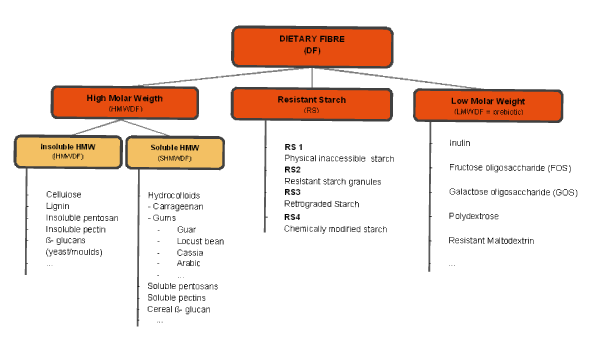Dietary Fibre Testing

Dietary fibres and prebiotics are a specific category of carbohydrates. The exact definition of dietary fibre has been subject to much controversy and discussion. The EU has adopted the CODEX Alimentarius definition meaning that dietary fibre is one of three categories of carbohydrate polymers: Naturally occurring edible carbohydrate polymers, carbohydrate polymers obtained from food raw material by physical, enzymatic or chemical means, and synthetic carbohydrate polymers. Also, dietary fibres should contain at least three monomeric units.
Importance of Dietary Fibres
Dietary fibres are essential in food. The different categories of dietary fibres have shown to benefit diabetes, blood cholesterol levels, body weight control (obesity) and reduction of the risk of coronary heart disease. This has led to an increased number of products with dietary fibre content claims. As result, new types of dietary fibres are industrially developed and commercially available. In congruence with this trend, the need for advanced testing methods which can determine the total dietary fibre content in foods has arisen. As science continuously evolves with the introduction of new types of dietary fibres, the classical testing methods have become outdated and give invalid test results. In the specific case of soluble and insoluble fibres, either high or low molar weights, the traditional methods for analysing dietary fibres cannot be trusted anymore.

Caloric value of Dietary Fibre
Dietary fibre has a nutritional value of 2 kcal/g, which is much lower than the nutritional value of 4 kcal/g for digestible carbohydrates. Erroneously too low established dietary fibre contents are always accompanied by erroneously too high (calculated) carbohydrate contents and thus with a too high energetic value of the product. Therefore our scientists have developed advanced and specific methods to measure the exact contents of dietary fibres in food. Moreover, depending on the total dietary fibre content and its specific constituents, various health claims are allowed. For example, some products can be claimed to be a ‘source of fibre’ or ‘high fibre’ (EU1924/2006). Therefore it is important to use the correct analytical method to measure the carbohydrate as well as the dietary fibre contents of your specific product.
Which method to use for Dietary Fibre Testing?
Due to the fast developments in new dietary fibres, a lot of different methods have been introduced to conduct analyses. For this reason the ‘classical’ Prosky method (AOAC 985.29) is not always the golden method of choice for the measurement of total dietary fiber analysis. The newly developed AOAC method 2009.01 and AOAC 2011.25 can replace the Prosky method in specific conditions. The AOAC 2011.25 method separates three categories of dietary fibres, (1) insoluble high molar weight dietary fibres (IHMWDF), including resistant starches, (2) soluble high molar weight dietary fibres (SHMWDF), and (3) low molar weight dietary fibres (LMWDF) commonly referred to as prebiotics.
Correct measurement of the dietary fibre content is important for:
- Correct labelling of the product.
- Decisive for granting label and health claims.
- Erroneous to low dietary fibre content is always accompanied with too high energetics value of the product.
Our Dietary Fibre Testing Brochure explains in detail what dietary fibres are and how to select the right test for a precise measurement. Moreover, the most frequently used analytical methods for the determination of (different categories) dietary fibre are shortly discussed.

















































